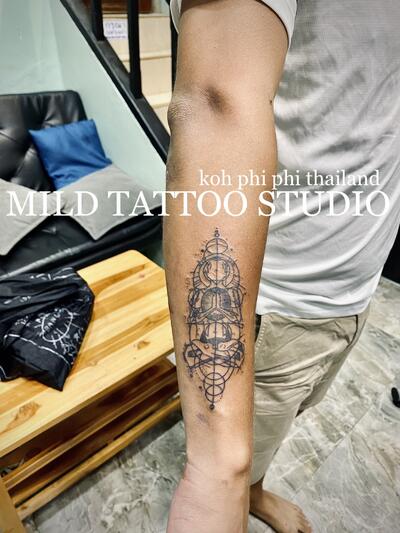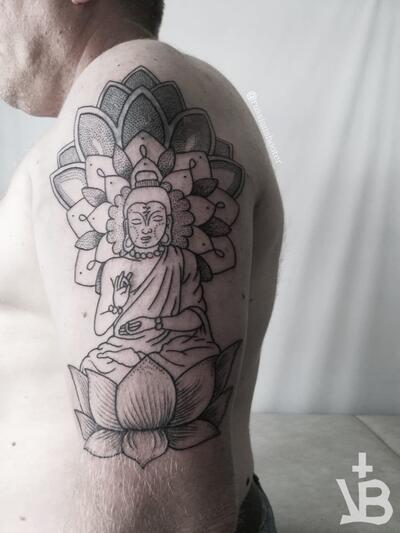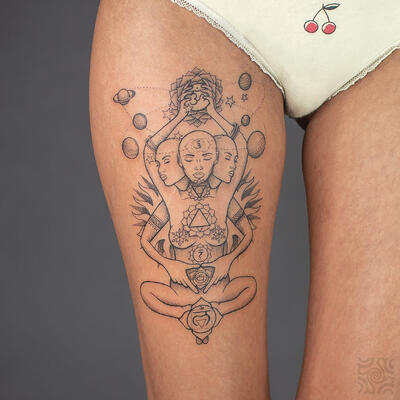Buddhist tattoos: varieties, meaning and prohibitions.
However, recently Buddhist tattoos are increasingly being chosen by secular people who are far from religion. These tattoos attract, first of all, with juicy colors and interesting sketches. Moreover, the meaning of many symbols is connected only with the culture and history of the Ancient East.
The meaning of Buddhist tattoos.
The main images for tattoos have deep historical roots and are considered traditional not only for Buddhism. It is noteworthy that their meaning has not changed much since their formation. Therefore, these images belong to the category of strong energy talismans:
- Tattoo of the Buddha. It gives peace of mind, protects the owner from various dangers, including dark magic;
- Lion tattoo. A symbol of the ruling house and unlimited power. In tattoos, it is interpreted as a sign that a person owns his emotions;
- Tattoo Sitting Hotey. As a tattoo, it is more suitable for women, since it protects the beautiful half of humanity, giving stability and well-being;
- The Bodhisattva tattoo. It helps a person to achieve enlightenment, to use all his strength to achieve the common good;
- The Sri Yantra tattoo is one of the most ancient symbols. Responsible for the development of intuition, helps to focus during meditation;
- The tattoo is a Buddhist knot. It reminds us of the interconnectedness of the entire world population;
- The Dharma Wheel tattoo. Suitable for those whose main goal in life is education.
- Tattoo Traces of the Buddha. In a general sense, it indicates many incarnations of the Buddha. In the religious sense, it indicates a person's readiness to follow in the footsteps of a Great teacher;
- The Lotus tattoo. Tattoo lotus is suitable for those who want to emphasize the purity of thoughts;
- Tattoo King Hong. It makes a person more sociable and pleasant to communicate with, helps in trading matters.
In addition to classical images, sacred inscriptions are very popular, which can be filled by masters trained in special techniques.
Sak Yant.
The religious painting of Sak Yant is perceived as a tattoo amulet. It is performed in the Khmer and Thai alphabets and consists of short mantras. Until recently, only a man could become a master of Sak Yant, tattoos were never filled for women. Today, no one follows these rules anymore.
The technique of applying Yant is interesting: the paint is injected under the skin using a sharpened bamboo stalk. According to tradition, during the work, the master must continuously chant mantras. And after applying the tattoo, tell important truths for Buddhists.
Sak Yant has never been considered as an ordinary tattoo. First of all, it is a strong magic talisman. The catch is that the tattoo will strengthen the prevailing sides in a person. Therefore, the choice of such a tattoo indicates full readiness for intense and painstaking work on yourself.
The most common types are the following:
- Amnai. Tattoo of power. Gives strength and suppresses the will of others;
- There's Kvaam. It helps to realize desires, including terrible ones;
- Maha Sanae. Responsible for love relationships;
- Kong Grapan Chatri. One of the most useful tattoos. Its presence makes a person invulnerable to any type of weapon. At least, that's what Buddhists believe;
- Jang Ngang. Tattoos of professional fighters.
- Sath Himapant. The owner of such a tattoo can adopt the abilities of animals
For Buddhists, Yantas are not just tattoos applied for fun. They carry a deep meaning, help to cope with difficult situations and can completely change a person's fate. Therefore, the decision to make such a tattoo should be considered and considered.
Popular sketches.
For those who still decided to do a Buddhist tattoo, the masters provide a wide selection of sketches of various sizes and complexity. In most cases, the central position in the tattoo will be occupied by the image of the Buddha, or one of his incarnations.
The most popular among Europeans (not counting Buddha images) are Hotei, elephant, lotus and Dharma wheel. Most often, these are full-color tattoos of a large size. Although recently there has been a trend towards more modest monochrome options and a concise image of objects.
We should also mention the image of mantras. The most popular in this series is the short mantra Om. Although there are options for applying longer texts, the choice of which will depend solely on the preferences of the carrier.
How to choose a place for a tattoo.
Sketches of Buddhist tattoos can be seen all over the body. Large-scale paintings adorn the backs, images of the Buddha are applied as a sleeve. Tattoos with animal elements are placed on the lower leg.
The Dharma wheel, as well as compact mantras, can be placed on the wrist, neck, shoulder or chest. Sak Yant, as the most sacred tattoo, is rarely placed below the waist. Although there are very nice options on the leg above the ankle. In addition, a professional master (in the east, monks are most often engaged in applying Sak Yant) will tell you where it is better to place Buddhist symbols, for each of which there is already a default place.
A dangerous tattoo.
In Buddhism itself, there is no call to decorate the skin with drawings. However, as well as prohibitions on carrying tattoos with a Buddhist theme. Only Tibetans disapprove of this practice, claiming that tattoos prevent the soul from leaving the body and leaving for the sacred world at the time of death.
But it is not spirits from the world of fine matter that should be feared on the territory of East Asian countries, but quite real local residents. Not all representatives of Buddhism have a positive attitude to non-believers who fill themselves with images of the Great Teacher or sacred symbols for Buddhists.
In Thailand, there have already been cases of delays at customs due to the image of the Buddha in the form of a tattoo. Today, they want to legalize the ban on the depiction of iconic symbols for Buddhists by foreigners at the state level.














